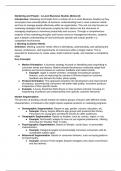Marketing and People - A-Level Business Studies (Edexcel)
Introduction: Marketing and People form a critical unit in A-Level Business Studies as they
encompass two essential pillars of business: understanding how to meet customer needs
and how to manage people effectively within an organization. This unit not only focuses on
marketing strategies that businesses employ but also delves into the intricacies of
managing employees to maximize productivity and success. Through a comprehensive
analysis of key marketing principles and human resource management theories, students
gain a deeper understanding of how businesses operate and sustain growth in a
competitive environment.
1. Meeting Customer Needs
Definition: Meeting customer needs refers to identifying, understanding, and satisfying the
desires, preferences, and requirements of consumers within a target market. This is
essential for businesses to create value, build customer loyalty, and maintain a competitive
edge.
Key Concepts:
● Market Orientation: A business strategy focused on identifying and responding to
consumer needs and desires. Market-oriented businesses continually adapt their
products and services based on customer feedback and market trends.
● Example: Apple is market-oriented, constantly innovating its product
features, such as improving the camera in iPhones based on customer
feedback and demand for better photo quality.
● Product Orientation: This approach prioritizes the development and improvement
of products, assuming that consumers will prefer high-quality, innovative products,
irrespective of their specific needs.
● Example: A luxury brand like Rolls-Royce is more product-oriented, focusing on
engineering excellence and craftsmanship over specific customer demands.
Market Segmentation:
The process of dividing a broad market into distinct groups of buyers with different needs,
characteristics, or behaviors who might require separate products or marketing programs.
● Demographic Segmentation: Based on age, gender, income, education, etc.
● Example: Disney targets different age groups with products like Disney
Princesses for young girls and Marvel movies for older audiences.
● Geographic Segmentation: Based on location, such as country, region, or city.
● Example: McDonald’s adapts its menu to suit regional preferences, offering
items like the “McAloo Tikki” in India.
● Psychographic Segmentation: Based on lifestyle, social class, or personality
characteristics.
● Example: Patagonia targets environmentally conscious consumers with its
sustainable outdoor gear.
● Behavioral Segmentation: Based on consumer behavior, such as buying patterns
or brand loyalty.
● Example: Amazon Prime targets frequent shoppers who value convenience
and fast delivery.
, Exam-Style Question:
Explain the differences between market orientation and product orientation, and evaluate
the potential benefits of a market-oriented approach for a business operating in the
technology sector (10 marks).
2. Market Research
Definition: Market research is the systematic collection, analysis, and interpretation of data
about the target market, competition, and consumer behavior. It helps businesses make
informed decisions about product development, marketing strategies, and customer
satisfaction.
Types of Market Research:
● Primary Research (Field Research): Involves gathering new, first-hand data
directly from the source, such as through surveys, interviews, focus groups, or
observations.
● Example: Nike conducting focus groups to understand consumer preferences
for new sportswear designs.
● Secondary Research (Desk Research): Involves analyzing existing data that has
already been collected for another purpose, such as industry reports, academic
journals, or government publications.
● Example: A company using existing market reports to analyze trends in the
retail industry.
Research Methods:
● Quantitative Research: Focuses on numerical data and statistics, often collected
through surveys with closed-ended questions. It helps quantify behaviors, attitudes,
and market trends.
● Example: A survey asking 1,000 customers how often they purchase a
particular product, with responses recorded numerically.
● Qualitative Research: Seeks to understand opinions, motivations, and feelings
through open-ended questions and discussions in interviews or focus groups.
● Example: A focus group exploring customer satisfaction with a luxury hotel’s
service experience.
Diagrams:
A Market Research Process Flowchart might be used to visualize the steps involved:
1. Defining the problem.
2. Developing the research plan.
3. Collecting data.
4. Analyzing the data.
5. Presenting findings.
3. Market Positioning
Definition: Market positioning is the process of creating an image or identity for a product in
the minds of the target audience. Effective positioning differentiates a product from
competitors and highlights its unique benefits.




